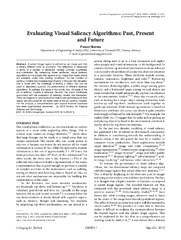Evaluating Visual Saliency Algorithms: Past, Present and Future
Permanent lenke
https://hdl.handle.net/10037/8991Åpne
Hovedartikkel (PDF)
(Microsoft Word)
Dato
2015-09-01Type
TidsskriftartikkelPeer reviewed
Journal article
Forfatter
Sharma, PuneetSammendrag
With the introduction of compressed sensing (CS) theory, investigation into exploiting sparseness and optimizing compressive sensing performance has ensued. Compressed sensing is highly applicable to images, which naturally have sparse representations. Improvements in the area of image denoising have resulted from the combination of highly-directional transforms with shrinkage and thresholding techniques along with imposition of a model to account for statistical properties of images. Using this approach, statistical modeling of dependencies in the transform domain is incorporated into high-performance and efficient state-of-the-art CS image reconstruction algorithms with highly-directional transforms incorporating redundancy and bivariate shrinkage and thresholding to further refine image reconstruction performance improvements. Additionally, hierarchical structural dependency modeling is incorporated to account for parent‐child coefficient relationships. These techniques exploit hierarchical structure and multiscale subbands of frequencies and orientation, exploiting dependencies across and within scales. Additionally, these techniques are incorporated with minimal additional CPU execution time into block-based CS (BCS) algorithms, which are known for their efficient and fast computation time. Experimental results show increased refinements of image reconstruction performance over current state-of-the-art image reconstruction algorithms, particularly at the higher CS ratios (lower sampling rates) of interest in compressed sensing.
Beskrivelse
-


 English
English norsk
norsk